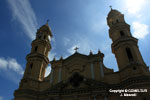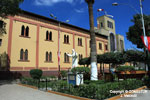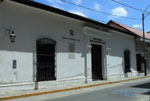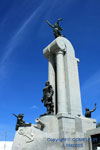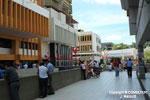Piura City
Known as the city of hospitality, the city of eternal sun, or the city of the carob.
It was the first city founded by the Spanish in Peru with the name of San Miguel de Piura, located in Tangarará (1532), then transferred to Paita which was plundered by pirates (1577) and then moved to its present location (1587), now due to urban sprawl today is located on both banks of the Piura River, connected by 4 bridges with the area of Castilla.
In its historical center is located some churches and colonial houses, highlighting its cathedral and the Church of St. Francis of Assisi, and small museums like the Museo de Oro Vicus and the Casa Museo del Almirante Miguel Grau.
Good restaurants and taverns to enjoy piurana food and a good range of hotels and night clubs. Its location is most recommended as a starting point to visit Catacaos and Chulucanas.
Plaza de Armas (Main Square)
is located in the center of the city. It is surrounded by tamarind trees, which were brought from the ranch and planted Yapatera since 1870. In the center is the "Pola" iconic figure of Piura, marble statue representing liberty and was presented by President José Balta, in 1870.
Cathedral of Piura
Huancavelica Street N° 362. Visiting hours: Mon 7:00 to 8:00 and 19:00 to 20:00, Sat and Sun 8:00 to 12:00. Founded in 1588 under the patronage of Our Lady of the Assumption and St. Michael the Archangel. Inside a reredos Churrigueresque Lady of Fatima Nicaragua carved cedar and covered with gold leaf was probably one of the first in Peru. The altar was rebuilt by the Spanish sculptor Julian Alagua after the earthquake of 1912 following the plateresque. As a mother church keeps the parish archives of Piura.
San Francisco Church
Street Intersection Eguiguren Lima Malecon No. 516. Visiting hours: Mon 8:00 to 12:00 and 16:00 to 19:00. Masses: 8:30 am and 5:30 pm Old cloister built by the Franciscans during the eighteenth century. It was declared a national monument in 1969 and 1980. The main altar is Neoclassical, two niches and four circular columns, two on each side. One of the most important aspects of this church is its typical wooden chairs brown side, where once the monks in religious celebrations.
Del Carmen Church
It dates from the eighteenth century and was declared a National Historical Monument in 1974. Today, it houses the Museo de Arte Religioso (Religious Art Museum).
Religious Art Museum
This place was founded by Bishop Baltasar Jaime, and is characterized by an exquisite colonial style belonging to the seventeenth century. An example is the typical facade located on the exterior of the building, which is made of wood with semicircular thresholds, two columns on each side and an old window with iron bars. Inside the museum is the altar, important piece, which shows the unique baroque style of the era, is carved in wood and covered with gold leaf, whose niche lies the image of the Virgen del Carmen. Also, find a showcase a cross made of rock crystal, medals reminder of Eucharistic congresses and the beatification of Monsignor Escrivá de Balaguer. Also shown are two doors, which are carved the four evangelists (Matthew, Mark, Luke and John) in high relief. The museum has two important historic carvings, which are the image of the Virgen de Agua Santa, considered the oldest has Piura, and the image of the Virgen del Carmen, which used to go in procession central time. The report also presents other objects such as altarpieces, canvases, Christs of ivory, carved images, and so on. Visits: Monday to Friday from 9:00 a.m. to 1:00 pm.
Ignacio Merino Square
Is located between the intersections of La Libertad and Sanchez Cerro avenues. This square is named in honor to the the great painter of Piura Jose Ignacio Merino, and his monument is surrounded by 4 beautiful gardens. Found around the Museum of Religious Art, the former Salesian College, Mary Help of Christians Church and the local of National Culture Institute.
San Sebastian Church
Located in Moquegua street, between Tacna and La Libertad streets. It was given to the Redemptorist Missionaries on July 8, 1911. Emphasize its stained glass depicting images of San Sebastian, San Gerardo, Santa Rosa, Sacred Heart of Jesus and St. Joseph. It also has a crypt where daily Masses are held in memory of deceased persons. This church has a large legion of faithful of Our Lady of Perpetual Help.
House Museum of Admiral Miguel Grau
Jiron Tacna N° 662. Visiting hours: Mon. – Fri. 8:00 A.M. – 1:00 P.M. and 3:30 P.M. – 6:00 P.M. This is the house where Admiral Miguel Grau, hero of the War of the Pacific (the war against Chile, 1879) was born and lived. The home consists of four large rooms and a library. Besides the furniture used by the Great Admiral, you can see pictures, letters, diplomas, and documents.
Vicus Museum
Intersection of Avenida Sullana and Jiron Huanuco. Visiting hours: Mon. – Sat. 8:00 A.M. – 10:00 P.M; Sun. 8:00 A.M. – 12:00 P.M. Inside showrooms are packed with over 2700 pieces belonging to the Vicus culture, among which is the famous collection of gold Frías, which highlights the famous Goddess of Frias and a set of 61 gold objects, illustrating the development and technology of ancient northern culture. Also, the museum is opening its doors to other expressions of regional culture as Chusis, Olleros and Workshop.
Three Cultures Square
Is located in the fifth block of Lima street. With a rectangular shape, this square has been recently remodeled, has a central monument of the conqueror Francisco Pizarro and his sides two ornamental pools lights give it a special night to Piura.
Exhibition Hall of the Central Reserve Bank of Peru
Located opposite the Plaza de Armas. Inside is an important environmental exhibition hall, in which are shown various objects from the Vicus culture. Among them we have the ceramics, the most common being bottles with stirrup and neck trim. This pottery is characterized by its natural and realistic representations. Likewise, there are also objects of gold, silver and bronze worked with the technique of rolling, welding and casting. Are exposed on the other hand, the collection of notes of 1, 5, 10 and 20 soles, which gave the Bank of Piura in 1873, which have become rare pieces and of great interest to visitors.

